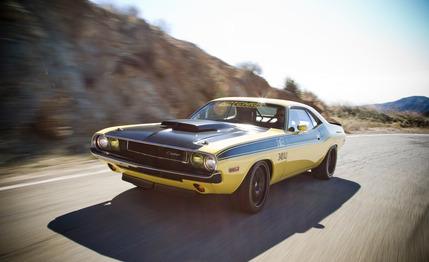
 Specialty File
Specialty File


When Dodge finally got around to answering the Mustang and Camaro in 1970, designer Carl Cameron’s coupe went wide and mouthy with the sheetmetal and put the occupants in a sort of speed bunker behind a big engine. Of course, the Challenger was a child of its era, dependent on a loud throttle and not much else for its performance. Places like Dead Man’s Curve thus exacted their butcher’s bills.
Nowadays, the trend in vintage muscle machinery is to modernize beneath the skin while leaving largely intact the enduring works of Cameron and his contemporaries. That means suspension and brake work, for starters, and the Hotchkis E-Max Challenger is a showboat for one company’s relatively affordable bolt-on handling kits.
Hotchkis Sport Suspension, in the Los Angeles suburb of Santa Fe Springs, built up the roughly $70,000 E-Max from an eBay find. The black-and-yellow war paint, the 18-inch Forgeline ZX3 wheels ($3900), the Sparco Milano front buckets ($800), and the custom fiberglass air-scooping hood notwithstanding, the E-Max isn’t a fully reengineered Pro Touring overhaul on par with the six-figure ’69 “Red Devil” Camaro we profiled in August 2011.


This E-body Challenger (hence the name, which basically means “E to the max”) retains more of its vintage shaky vibe, with its original six-pack-carb setup atop a cammed-up 340 Mopar small-block V-8, bored 0.030 over and rattling the chassis’ loose rafters through Flowmasters and thundering side exhaust outlets. When it’s cold, you can hear each cylinder firing like individual sticks of dynamite, a raunchy piper’s tune that draws out the neighborhood’s 14-to-18-year-old male population in herds. A five-speed Tremec transmission adds a welcome overdrive and digs the 3524-pound hunk of teen fantasy out of a hole briskly.
The 60-mph mark passed in 5.3 seconds, but the first couple of upshifts proved balky, as though the transmission were tired, and pushed the quarter-mile to 14 seconds flat.